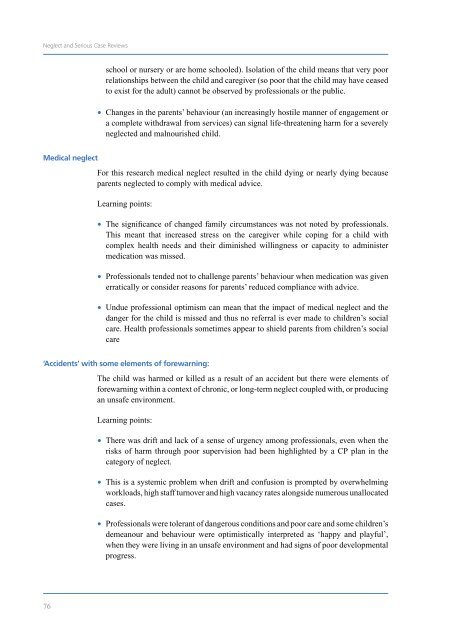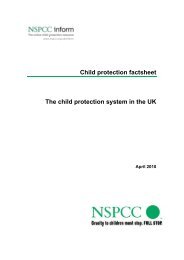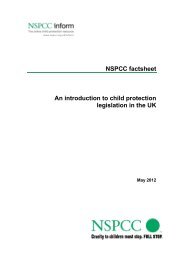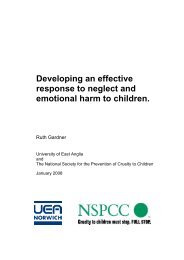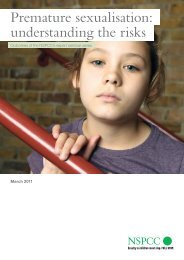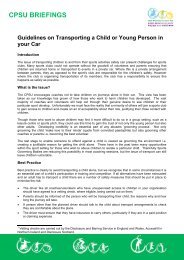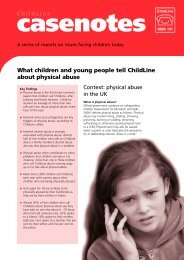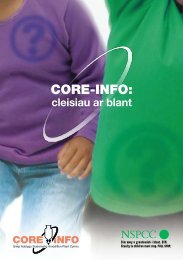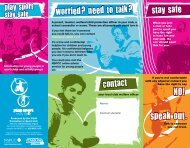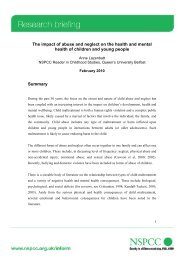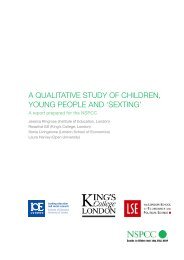Neglect and serious case reviews (PDF, 735KB) - nspcc
Neglect and serious case reviews (PDF, 735KB) - nspcc
Neglect and serious case reviews (PDF, 735KB) - nspcc
Create successful ePaper yourself
Turn your PDF publications into a flip-book with our unique Google optimized e-Paper software.
<strong>Neglect</strong> <strong>and</strong> Serious Case Reviews<br />
medical neglect<br />
school or nursery or are home schooled). Isolation of the child means that very poor<br />
relationships between the child <strong>and</strong> caregiver (so poor that the child may have ceased<br />
to exist for the adult) cannot be observed by professionals or the public.<br />
• Changes in the parents’ behaviour (an increasingly hostile manner of engagement or<br />
a complete withdrawal from services) can signal life-threatening harm for a severely<br />
neglected <strong>and</strong> malnourished child.<br />
For this research medical neglect resulted in the child dying or nearly dying because<br />
parents neglected to comply with medical advice.<br />
Learning points:<br />
• The significance of changed family circumstances was not noted by professionals.<br />
This meant that increased stress on the caregiver while coping for a child with<br />
complex health needs <strong>and</strong> their diminished willingness or capacity to administer<br />
medication was missed.<br />
• Professionals tended not to challenge parents’ behaviour when medication was given<br />
erratically or consider reasons for parents’ reduced compliance with advice.<br />
• Undue professional optimism can mean that the impact of medical neglect <strong>and</strong> the<br />
danger for the child is missed <strong>and</strong> thus no referral is ever made to children’s social<br />
care. Health professionals sometimes appear to shield parents from children’s social<br />
care<br />
‘accidents’ with some elements of forewarning:<br />
76<br />
The child was harmed or killed as a result of an accident but there were elements of<br />
forewarning within a context of chronic, or long-term neglect coupled with, or producing<br />
an unsafe environment.<br />
Learning points:<br />
• There was drift <strong>and</strong> lack of a sense of urgency among professionals, even when the<br />
risks of harm through poor supervision had been highlighted by a CP plan in the<br />
category of neglect.<br />
• This is a systemic problem when drift <strong>and</strong> confusion is prompted by overwhelming<br />
workloads, high staff turnover <strong>and</strong> high vacancy rates alongside numerous unallocated<br />
<strong>case</strong>s.<br />
• Professionals were tolerant of dangerous conditions <strong>and</strong> poor care <strong>and</strong> some children’s<br />
demeanour <strong>and</strong> behaviour were optimistically interpreted as ‘happy <strong>and</strong> playful’,<br />
when they were living in an unsafe environment <strong>and</strong> had signs of poor developmental<br />
progress.


